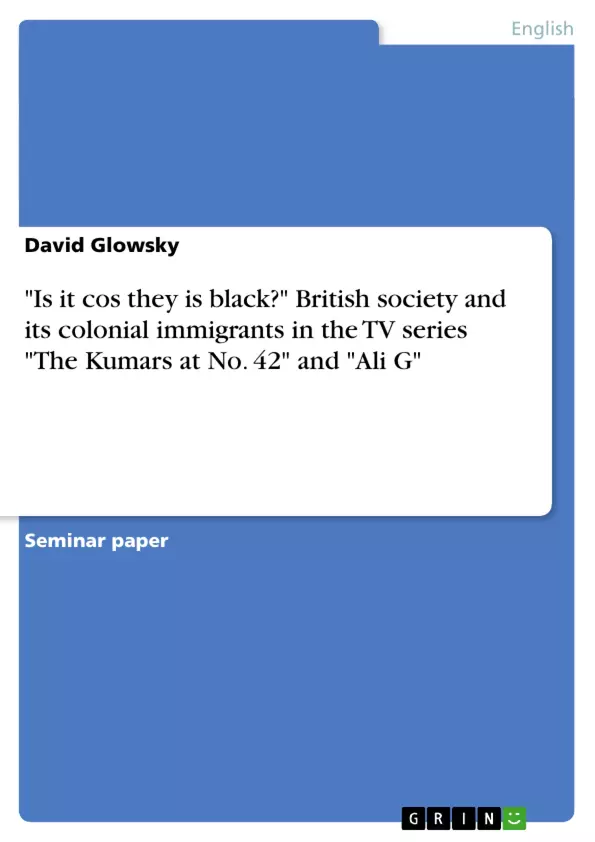British society has undergone a considerable change of its composition in the past fifty
years. Unprecedented numbers of immigrants came to Great Britain after World War II.
The traditional populatio n, which had been rather homogeneous until then, was confronted
with foreign-looking people who came from former colonies and whose identities seemed
anything but British. Since then, the proportion of non-white Britons of the population has
risen steadily. Their influx was increasingly made difficult, when the voices against such
immigrants grew stronger. The national self-image of a white British nation became more
and more problematic. At present British self-understanding is undergoing a shift away
from the traditional viewpoint to an awareness of changed circumstances.
In this setting the essay at hand will investigate signs of that shift in two British TV
series formats, namely “The Kumars at No. 42” and “Ali G”. It will show how remaining
tensions between the immigrant and the traditional population are being dealt with and
how new ways of coexistence are negotiated. The main focus will be an analysis of
strategies to break down old imperial structures and sublime ways to question British selfimages.
Both TV series have their own ways of turning the imperial tables and presenting
British society in a critical light.
The essay is divided into two parts. In the first section, an overview of British
immigration history since 1945, followed by a discussion of British national sentiment will
be given. The second section analyses the strategies of the two series against this backdrop.
Inhaltsverzeichnis (Table of Contents)
- Introduction
- Ethnic minorities in Great Britain since 1945
- Reasons for immigration to Great Britain since 1945
- British immigration policy since 1945
- Nationalist sentiment and racism in Great Britain today
- "The Kumars at No. 42" and "Ali G"
- The Kumars at No. 42
- Ali G
- Conclusion
Zielsetzung und Themenschwerpunkte (Objectives and Key Themes)
The essay investigates the portrayal of British society and its colonial immigrants in the TV series "The Kumars at No. 42" and "Ali G." The primary objective is to analyze how these series address the remaining tensions between immigrant and traditional populations in Britain and explore how new ways of coexistence are negotiated. The focus is on strategies to dismantle old imperial structures and critically examine British self-images.
- The impact of post-World War II immigration on British society and identity.
- The changing relationship between the UK and its former colonies, particularly in terms of immigration.
- The development of nationalist sentiment and racism in Britain in response to immigration.
- The strategies employed by "The Kumars at No. 42" and "Ali G" to subvert and critique traditional British perspectives.
- The negotiation of new forms of coexistence between immigrant and traditional communities.
Zusammenfassung der Kapitel (Chapter Summaries)
- Introduction: This chapter sets the stage for the essay by outlining the significant demographic changes in British society since World War II, particularly the influx of immigrants from former colonies. It highlights the evolving British self-understanding, moving from a traditional homogenous view to an awareness of diverse populations.
- Ethnic minorities in Great Britain since 1945: This chapter delves into the history of ethnic minorities in Britain after World War II. It examines the factors that led to the immigration of colonial subjects, including post-war labor shortages, changing colonial relationships, and economic initiatives. It also discusses the development of national sentiment and racism in response to this immigration.
- Reasons for immigration to Great Britain since 1945: This chapter provides a detailed analysis of the reasons for the influx of colonial immigrants to Britain after World War II. It examines the role of government policies, economic forces, and the changing dynamics of the British Empire. It also highlights the complexities of immigration policy and the contrasting perspectives on the influx of immigrants.
- British immigration policy since 1945: This chapter focuses on the policies governing immigration to Britain after World War II. It explores the tensions between the theoretical right of colonial subjects to settle in the UK and the practical limitations imposed by the government. It also discusses the evolving attitudes towards colonial immigration and the emergence of policies aimed at regulating immigrant flows.
- Nationalist sentiment and racism in Great Britain today: This chapter examines the rise of nationalist sentiment and racism in response to post-war immigration. It discusses the impact of these ideologies on British society and the challenges faced by ethnic minorities in integrating into mainstream culture. It also explores the complexities of race relations and the evolving perceptions of national identity.
Schlüsselwörter (Keywords)
Key terms and topics in the essay include British immigration, colonial history, post-war society, ethnic minorities, national identity, racial tensions, social integration, satire, television, "The Kumars at No. 42," "Ali G," and cultural representation.
- Quote paper
- David Glowsky (Author), 2003, "Is it cos they is black?" British society and its colonial immigrants in the TV series "The Kumars at No. 42" and "Ali G", Munich, GRIN Verlag, https://www.grin.com/document/21513



